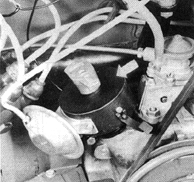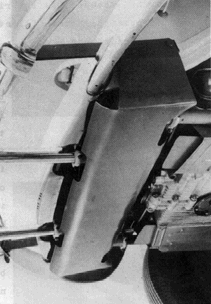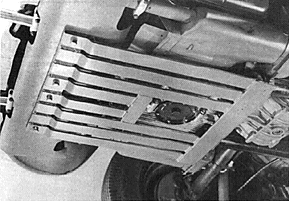Instructions for
Tropical Climate Operation
Tropical Climate Operation
A - Introduction
- This pamphlet describes a number of additional measures which can be taken to protect Passenger Cars and Transporters against excessive heat, dust and damage from flying stones. It also contains hints on preparing the vehicle for an extended trip and maintenance during the trip as well as suggestions for spare parts and accessories to be taken.
B - Special Preparations
-
- 1 - General
- No modifications to the construction of the
various VW vehicles are necessary before starting on a
jurney through tropical countries. It is, however,
strongly recommended that the vehicle be thoroughly
inspected at an authorised VW Service Station before a
long trip is made. Such an in spection calls for
special attention to be paid to the condition and
proper position of the engine compartment sealing
strips. In order to avoid an accumulation of dust and
a consequent restriction of the air cooling, it is
important to eliminate any engine oil leaks.
The lubrication and maintenance services which become due during a journey should, if possible, be entrusted to VW Service Stations. If this is not possible, the Instruction Manual can be used as a guide to enable other workshops to carry out the necessary operations as specified by the Factory. The Instruction manual is available in many languages.
2 - Engine and fuel system
a - Air cleaner and engine comartment sealing.
- If the route to be taken passes through very dusty
regions the large oil bath air cleaner with a cyclone
filter should be service installed. This air cleaner
equipment is available under the following part
numbers:
Passenger Cars
34 bhp engine (40 SAE bhp) SP 80 A
30 bhp engine (36 SAE bhp) SP 80Transporters
34 bhp engine SP 81 A
30 bhp engine SP 81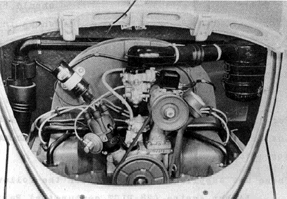 The air cleaner maintenance is fully eplained in the
Instruction Manual.
The air cleaner maintenance is fully eplained in the
Instruction Manual.When installing the air cleaner, take care that the joint between the in take manifold and carburetor is properlly sealed to prevent the entry of unfiltered air.
b - Carburetor
The entry of dust into the engine compartment can be prevented by fitting additional sealing strips. On request, all Transporter models can be supplied complete with this equipment under Optional Extra 10. The sealing strips are also supplied as spares under S.P. 210 for service installation in all Passenger Cars and Transporters.
The cyclone filter and additional sealing can be installed in any VW Workshop.
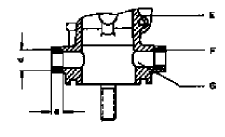
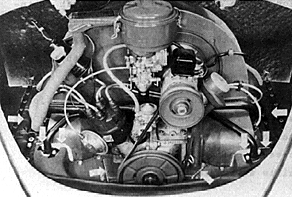
a = 5 mm (0.20")
d = 10 mm (0.39")
E = Carburetor body
F = Felt ring
G = Throttle valve shaft holes- The carburetor linkage should be thoroughly
cleaned and coated with graphite powder (not oiled)
before starting the trip.
The holes for the throttle valve shaft should be sealed with felt rings as shown in the sketch. These felt rings are not supplied as spares but must be manufactured in the Workshop.
For journeys in regions which are over 2000 m above sea level, such as in the South American mountains, it is recommended that a high altitude corrector should be installed
These are supplied as spares under the following part numbers:
34 bhp engine (28 PICT carburetor) Part No. 113 129 501.
30 bhp engine (28 PCI carburetor) Part No. 111 129 501.
c - Oil filler cap with breather pipe
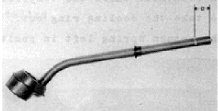 a = 3 cm (1.18")
a = 3 cm (1.18")
The oil filler cap must provide adequate crankcase ventilation. To avoid damage and blockage when traversing very rough country, the breather pipe should be shortened about 3cm (1.18"). The pipe is then restored to its original length with a piece of rubber tubing. This modification is not necessary on vehicles with engine shields.
d - Oil dipstick
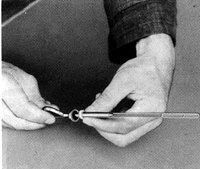
The dipstick should be sealed by fitting a felt washer under the cap at the top. It may be necessary to bend the dipstick slightly to ensure that it fits tightly in the guide tube.
e - Automatic air cooling
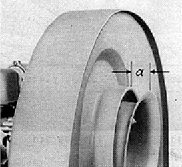 a = 25-30 mm (.8"-1")
a = 25-30 mm (.8"-1")
There is no need to remove the automatic air cooling system or put it out of action when travelling in tropical countries. The system must, however, be functioning properly and adjusted correctly to avoid engine trouble. All VW Workshops are familiar with the adjustment of the cooling air ring. The thermostat is operating properly when the ring is 25-30mm (.8"-1") open when the engine is warm.
In countries where the temperature is extremely high it may be an advantage to take the cooling ring out. The two 6 mm screws should be removed but the return spring left in position. The ring is then taken out.
f - Oil filter
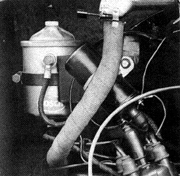 If the car is driven in extremely dusty areas where
the service facilities do not permit oil changes at
the specified intervals, it is recommended that a
by-pass oil filter be installed. The filter maintains
the lubricating qualities of the oil over prolonged
periods.
If the car is driven in extremely dusty areas where
the service facilities do not permit oil changes at
the specified intervals, it is recommended that a
by-pass oil filter be installed. The filter maintains
the lubricating qualities of the oil over prolonged
periods.
A by-pass oil filter can be installed at any VW Service Station according to the manufacturer's instructions delivered with the filter.
g - Ignition distributor
- The current production ignition distributor can be
provided with a cover plate to keep out dust:
